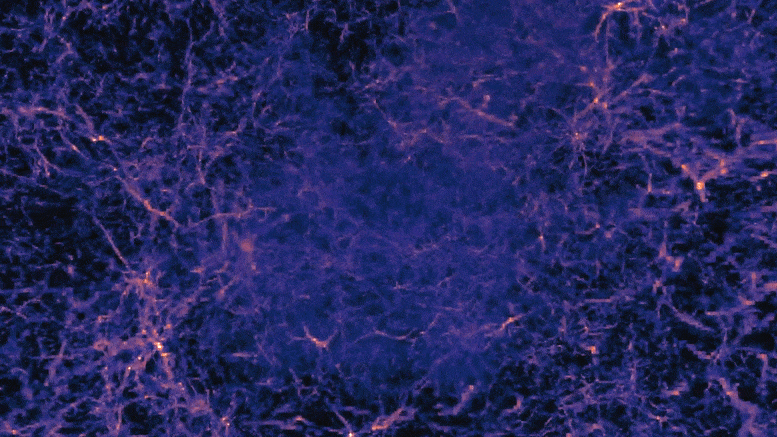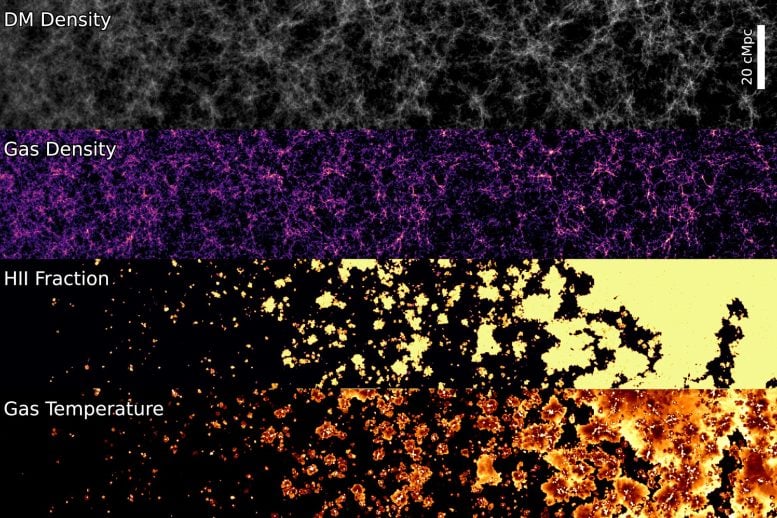
Thesan modelando pequeño video. Mira el video en el artículo a continuación.
Nombrado en honor a la diosa del amanecer, Thezan, los primeros mil millones de años de modelado ayudan a explicar cómo la radiación formó el universo primitivo.
Todo comenzó hace unos 13.800 millones de años con una gran «explosión» cósmica que de repente creó el universo de una manera impresionante. Poco después, el universo del bebé se congeló y se oscureció por completo.
Luego, durante varios cientos de millones de años[{» attribute=»»>Big Bang, the universe woke up, as gravity gathered matter into the first stars and galaxies. Light from these first stars turned the surrounding gas into a hot, ionized plasma — a crucial transformation known as cosmic reionization that propelled the universe into the complex structure that we see today.
Now, scientists can get a detailed view of how the universe may have unfolded during this pivotal period with a new simulation, known as Thesan, developed by scientists at MIT, Harvard University, and the Max Planck Institute for Astrophysics.
Named after the Etruscan goddess of the dawn, Thesan is designed to simulate the “cosmic dawn,” and specifically cosmic reionization, a period which has been challenging to reconstruct, as it involves immensely complicated, chaotic interactions, including those between gravity, gas, and radiation.
The Thesan simulation resolves these interactions with the highest detail and over the largest volume of any previous simulation. It does so by combining a realistic model of galaxy formation with a new algorithm that tracks how light interacts with gas, along with a model for cosmic dust.

Evolution of simulated properties in the main Thesan run. Time progresses from left to right. The dark matter (top panel) collapse in the cosmic web structure, composed of clumps (haloes) connected by filaments, and the gas (second panel from the top) follows, collapsing to create galaxies. These produce ionizing photons that drive cosmic reionization (third panel from the top), heating up the gas in the process (bottom panel). Credit: Courtesy of THESAN Simulations
With Thesan, the researchers can simulate a cubic volume of the universe spanning 300 million light years across. They run the simulation forward in time to track the first appearance and evolution of hundreds of thousands of galaxies within this space, beginning around 400,000 years after the Big Bang, and through the first billion years.
So far, the simulations align with what few observations astronomers have of the early universe. As more observations are made of this period, for instance with the newly launched James Webb Space Telescope, Thesan may help to place such observations in cosmic context.
For now, the simulations are starting to shed light on certain processes, such as how far light can travel in the early universe, and which galaxies were responsible for reionization.
“Thesan acts as a bridge to the early universe,” says Aaron Smith, a NASA Einstein Fellow in MIT’s Kavli Institute for Astrophysics and Space Research. “It is intended to serve as an ideal simulation counterpart for upcoming observational facilities, which are poised to fundamentally alter our understanding of the cosmos.”
Smith and Mark Vogelsberger, associate professor of physics at MIT, Rahul Kannan of the Harvard-Smithsonian Center for Astrophysics, and Enrico Garaldi at Max Planck have introduced the Thesan simulation through three papers, the third published on March 24, 2022, in the Monthly Notices of the Royal Astronomical Society.
Follow the light
In the earliest stages of cosmic reionization, the universe was a dark and homogenous space. For physicists, the cosmic evolution during these early “dark ages” is relatively simple to calculate.
“In principle you could work this out with pen and paper,” Smith says. “But at some point gravity starts to pull and collapse matter together, at first slowly, but then so quickly that calculations become too complicated, and we have to do a full simulation.”
To fully simulate cosmic reionization, the team sought to include as many major ingredients of the early universe as possible. They started off with a successful model of galaxy formation that their groups previously developed, called Illustris-TNG, which has been shown to accurately simulate the properties and populations of evolving galaxies. They then developed a new code to incorporate how the light from galaxies and stars interact with and reionize the surrounding gas — an extremely complex process that other simulations have not been able to accurately reproduce at large scale.
“Thesan follows how the light from these first galaxies interacts with the gas over the first billion years and transforms the universe from neutral to ionized,” Kannan says. “This way, we automatically follow the reionization process as it unfolds.”
Finally, the team included a preliminary model of cosmic dust — another feature that is unique to such simulations of the early universe. This early model aims to describe how tiny grains of material influence the formation of galaxies in the early, sparse universe.
https://www.youtube.com/watch?v=17iLOLn9znY:
El modelo Thesan de la evolución de la radiación de gas muestra la producción de gas de hidrógeno neutro. Los colores representan densidad և brillo, revelando la estructura de la ionización moteada en una red de filamentos de gas neutro de alta densidad.
puente espacial
Con los componentes de simulación disponibles, el equipo estableció sus condiciones iniciales unos 400.000 años después del Big Bang basándose en mediciones precisas de la luz reliquia del Big Bang. Posteriormente desarrollaron estas condiciones con el tiempo para simular una parte del universo utilizando la máquina SuperMUC-NG, una de las supercomputadoras más grandes del mundo, que ensambló simultáneamente 60 000 núcleos de computación equivalentes a 30 millones de procesadores equivalentes a Teesan. horas (esfuerzo que tardará 3.500 años en funcionar en un escritorio).
Las simulaciones crean una imagen más detallada de la ionización espacial, con la mayor cantidad de espacio, a partir de cualquier simulación existente. Mientras que algunas simulaciones simulan largas distancias, lo hacen a resoluciones relativamente bajas, mientras que otras, simulaciones más detalladas, no involucran grandes volúmenes.
«Unimos estos dos enfoques. “Tenemos un gran volumen y una alta resolución”, enfatiza Fogelsberger.
Los primeros análisis de modelos mostraron que al final de la ionización espacial, la distancia de la luz podía viajar más rápido de lo que pensaban los científicos.
«La tesis ha encontrado que la luz no viaja largas distancias al comienzo del universo», dice Canaan. «De hecho, esta distancia es muy pequeña; solo aumenta al final de la ionización, aumentando en 10 en solo unos pocos cientos de millones de años».
Los investigadores también ven indicios del tipo de galaxias responsables de la ionización. Es probable que la masa de la galaxia afecte la ionización, y el equipo dice que más observaciones realizadas por James Webb y otros observatorios ayudarán a encontrar estas galaxias dominantes.
«Tenemos muchas partes móviles [modeling cosmic reionization]», – concluye Fogelsberger. “Cuando podemos juntar todo esto en algún tipo de automóvil, ponerlo en marcha, produce un universo dinámico, es un momento muy gratificante para todos nosotros”.
Referencia. «Proyecto Tesan. Lyman: Emisiones y transiciones en la era de la regionalización «A. Smith, R. Cannan, E. Garaldi, M. Por Fogelsberger, R. Pacmore, W. Springell L. Hernquist, 24 de marzo de 2022 Notificaciones mensuales de la Royal Astronomical Society.
DOI: 10.1093/mnras/stac713:
Esta investigación fue parcialmente apoyada por la NASA, la Fundación Nacional de Ciencias y el Centro Gauss para Supercomputadoras.

Aficionado a los viajes. Lector exasperantemente humilde. Especialista en internet incurable
 Impulsse.la Complete News World
Impulsse.la Complete News World
